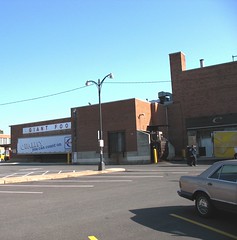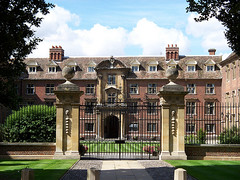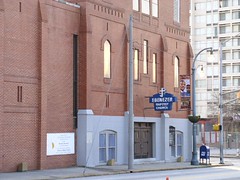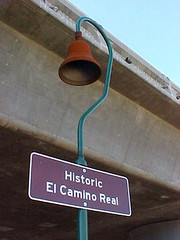In sustainable communities, architecture, and preservation, does beauty matter? Should it?

Posted February 24, 2009 at 1:30PM
I am going to answer the questions with a yes and another yes, and say also that I am intrigued by some people in the field who say that architectural beauty can be defined. I'm not sure I agree, but I'm intrigued. But, first, let me put this in context with a story.
 I was in a committee meeting about a month ago where a couple of us were pushing for greater recognition of historic preservation in our movement's advocacy for smart, green neighborhoods. Increasingly, the National Trust is asserting that older buildings are inherently green, and certainly some of our most beloved examples of enduring walkable communities - Alexandria, Rittenhouse Square, Pasadena, the Marais district in Paris, just to quickly pull a few examples - are historic by anyone's definition.
I was in a committee meeting about a month ago where a couple of us were pushing for greater recognition of historic preservation in our movement's advocacy for smart, green neighborhoods. Increasingly, the National Trust is asserting that older buildings are inherently green, and certainly some of our most beloved examples of enduring walkable communities - Alexandria, Rittenhouse Square, Pasadena, the Marais district in Paris, just to quickly pull a few examples - are historic by anyone's definition.
Heck, last year in this space I even pointed to medieval examples, les bastides in France's Dordogne region. One can make a compelling argument that to say historic communities are sustainable is a tautology.
But we were unsuccessful in getting more recognition for historic properties in this meeting. In fact, we were quickly silenced by the viewpoint that the application of a literalist definition of historic - "if it's old, it's historic" - by NIMBYs is actually preventing sustainable development, and the problem is only going to get worse as more mediocre buildings from the 1950s and 1960s pass the 50-year mark generally considered to define eligibility for landmark consideration.
 Here's an example that I have alluded to before: Not far from my neighborhood, a community is split over how to redevelop a faded commercial strip that includes a plain low box of an outmoded 1950s supermarket that no one loves. Opponents quickly gained the upper hand by pursuing a historic landmark designation for this mediocre building, tying up the approval process. (I'm told the petition was eventually abandoned, though there is concern that it might resurface.) Now, I assure you, the opponents had little to no interest in actually saving the building; the only thing the whole neighborhood agrees on is that everyone hates the old Wisconsin Avenue Giant and wants a new one in a new building in that spot. The fight is over what sort of development goes over and around the new building that will replace the "historic" one.
Here's an example that I have alluded to before: Not far from my neighborhood, a community is split over how to redevelop a faded commercial strip that includes a plain low box of an outmoded 1950s supermarket that no one loves. Opponents quickly gained the upper hand by pursuing a historic landmark designation for this mediocre building, tying up the approval process. (I'm told the petition was eventually abandoned, though there is concern that it might resurface.) Now, I assure you, the opponents had little to no interest in actually saving the building; the only thing the whole neighborhood agrees on is that everyone hates the old Wisconsin Avenue Giant and wants a new one in a new building in that spot. The fight is over what sort of development goes over and around the new building that will replace the "historic" one.
But, unfortunately, the credibility of the preservation movement suffered a blow because of this. I am only too familiar with the problem, since the same sorts who misuse preservation laws for personal ends are just as quick to misuse environmental laws when they provide the better leverage. As I have written here, I think those of us in the environmental community have a duty to set the record straight when the greater environmental or social value is jeopardized by overzealous NIMBYs. (Not all of them are overzealous, by the way; some are real heroes.)
 So not long after the meeting I ran into a preservationist friend - someone I admire and respect a great deal, a person of influence in the movement - and related my experience in the meeting. I tried to make the point that I thought the preservation movement had a problem that maybe they should begin to address, since their influence and credibility is at stake. I did not get the reaction I wanted. What I did get was a roll of the eyes and a quick rebuke that modernist buildings are just as historic as any other, and what people hate today might be what they like tomorrow. History is history.
So not long after the meeting I ran into a preservationist friend - someone I admire and respect a great deal, a person of influence in the movement - and related my experience in the meeting. I tried to make the point that I thought the preservation movement had a problem that maybe they should begin to address, since their influence and credibility is at stake. I did not get the reaction I wanted. What I did get was a roll of the eyes and a quick rebuke that modernist buildings are just as historic as any other, and what people hate today might be what they like tomorrow. History is history.
But I think my friend completely missed my point. I was not arguing against the landmarking of modernist buildings. In fact, I am a fan of modernist architecture and have been for all my adult life. Anyone who takes a look at my bookshelf can see that. My point, rather, was that we need to be more discerning about what is worth fighting for and what isn't, lest we lose our support. And that we need to be alert - preservationists and environmentalists alike - to those who harm our values by misusing them.
 Which finally brings me to the issue of beauty. There is no question that I and many others in the environmental movement came to this work because we had been moved by the beauty of nature. I pretty much say that in my bio for this blog. Beauty motivates.
Which finally brings me to the issue of beauty. There is no question that I and many others in the environmental movement came to this work because we had been moved by the beauty of nature. I pretty much say that in my bio for this blog. Beauty motivates.
Scott Doyon certainly agrees, and goes on to write in PlaceShakers and NewsMakers that beauty is not just in the eye of the beholder:
"Why do some attempts at preservation capture broad-based attention and support while others wither away as fringe acts of desperation? . . .
"[C]ertain proportions and arrangements are more pleasing than others. Not as a matter of personal opinion but as a collective, cultural agreement. We may not, as a nation of individuals, want to admit that we essentially view beauty in the same light, but tough luck. We do.
"Most would agree that, at some point, our built environment stopped responding to a shared, cultural understanding of what's beautiful and started expressing - at the upper end - the personal artistic ambitions of its designers and - at the lower end - the need to cut costs.
"Either way, the result has been buildings and places that often lack the one thing most likely to ensure their preservation - the ability to be loved and valued by the everyman."
Scott cites the work of green architect Steve Mouzon, who has some very interesting things to say about the importance of "lovable" buildings ("Any serious conversation about sustainable buildings must begin with the issue of Lovability . . .") and about some universally applicable parameters that influence our feelings about what appeals and what doesn't.
 In my opinion, it's not that simple. But beauty and lovability do matter when we are contemplating the long term. We should build beauty and lovability for the future and save what is beautiful and lovable about the past. (We should also save some places that are important, regardless of their beauty or lovability, because history happened there - the church where Martin Luther King, Jr., preached, for example.)
In my opinion, it's not that simple. But beauty and lovability do matter when we are contemplating the long term. We should build beauty and lovability for the future and save what is beautiful and lovable about the past. (We should also save some places that are important, regardless of their beauty or lovability, because history happened there - the church where Martin Luther King, Jr., preached, for example.)
Beauty and lovability are not necessarily the same, by the way. Watts Towers, for example, might be considered beautiful by few, because of their eccentricity. But they are considered lovable by many. Victorian architecture was once considered gaudy and tasteless, but now is revered. If a major building or neighborhood is at stake, I might err on the side of preservation if its lasting worth is uncertain.
 But let's get real. The Wisconsin Avenue Giant is neither beautiful nor lovable. Are we going to start saving Walmarts, which the National Trust has opposed in one community after another, when they are 50 years old just because they are 50 years old? The date is not all that far away. And, make no mistake: they will be representative of a period and style of architecture. If that's the principal test, they will pass. What about urban freeways that sliced through and destroyed historic neighborhoods? They, too, are now part of history.
But let's get real. The Wisconsin Avenue Giant is neither beautiful nor lovable. Are we going to start saving Walmarts, which the National Trust has opposed in one community after another, when they are 50 years old just because they are 50 years old? The date is not all that far away. And, make no mistake: they will be representative of a period and style of architecture. If that's the principal test, they will pass. What about urban freeways that sliced through and destroyed historic neighborhoods? They, too, are now part of history.
The issue, in my mind, isn't about modernism but about common sense. And it deserves better than a roll of the eyes. As someone who believes in preservation, I believe we ignore it at our peril.